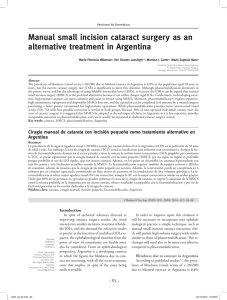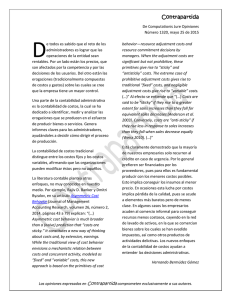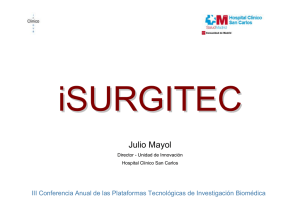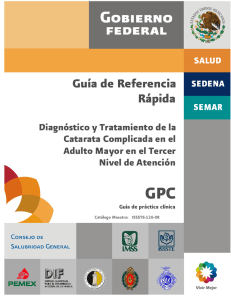The cost-effectiveness of cataract surgery
Anuncio
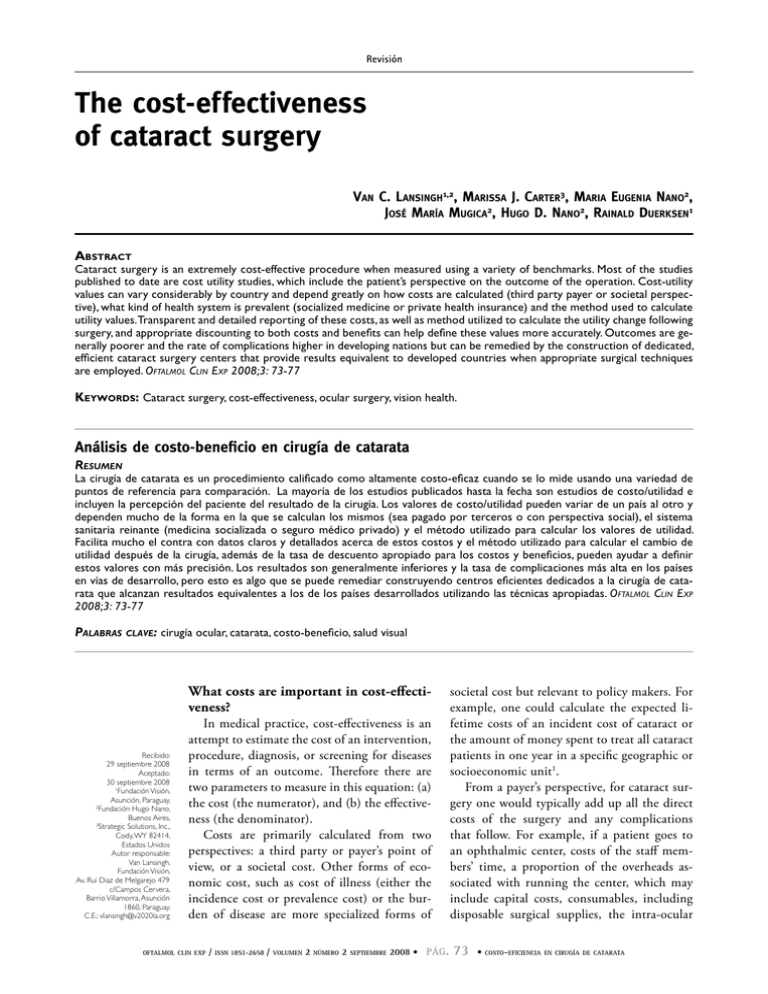
Revisión The cost-effectiveness of cataract surgery Van C. Lansingh1,2, Marissa J. Carter3, Maria Eugenia Nano2, José María Mugica2, Hugo D. Nano2, Rainald Duerksen1 Abstract Cataract surgery is an extremely cost-effective procedure when measured using a variety of benchmarks. Most of the studies published to date are cost utility studies, which include the patient’s perspective on the outcome of the operation. Cost-utility values can vary considerably by country and depend greatly on how costs are calculated (third party payer or societal perspective), what kind of health system is prevalent (socialized medicine or private health insurance) and the method used to calculate utility values.Transparent and detailed reporting of these costs, as well as method utilized to calculate the utility change following surgery, and appropriate discounting to both costs and benefits can help define these values more accurately. Outcomes are generally poorer and the rate of complications higher in developing nations but can be remedied by the construction of dedicated, efficient cataract surgery centers that provide results equivalent to developed countries when appropriate surgical techniques are employed. Oftalmol Clin Exp 2008;3: 73-77 Keywords: Cataract surgery, cost-effectiveness, ocular surgery, vision health. Análisis de costo-beneficio en cirugía de catarata Resumen La cirugía de catarata es un procedimiento calificado como altamente costo-eficaz cuando se lo mide usando una variedad de puntos de referencia para comparación. La mayoría de los estudios publicados hasta la fecha son estudios de costo/utilidad e incluyen la percepción del paciente del resultado de la cirugía. Los valores de costo/utilidad pueden variar de un país al otro y dependen mucho de la forma en la que se calculan los mismos (sea pagado por terceros o con perspectiva social), el sistema sanitaria reinante (medicina socializada o seguro médico privado) y el método utilizado para calcular los valores de utilidad. Facilita mucho el contra con datos claros y detallados acerca de estos costos y el método utilizado para calcular el cambio de utilidad después de la cirugía, además de la tasa de descuento apropiado para los costos y beneficios, pueden ayudar a definir estos valores con más precisión. Los resultados son generalmente inferiores y la tasa de complicaciones más alta en los países en vías de desarrollo, pero esto es algo que se puede remediar construyendo centros eficientes dedicados a la cirugía de catarata que alcanzan resultados equivalentes a los de los países desarrollados utilizando las técnicas apropiadas. Oftalmol Clin Exp 2008;3: 73-77 Palabras clave: cirugía ocular, catarata, costo-beneficio, salud visual What costs are important in cost-effectiveness? Recibido: 29 septiembre 2008 Aceptado: 30 septiembre 2008 1 Fundación Visión, Asunción, Paraguay, 2 Fundación Hugo Nano, Buenos Aires, 3 Strategic Solutions, Inc., Cody, WY 82414, Estados Unidos Autor responsable: Van Lansingh. Fundación Visión, Av. Rui Diaz de Melgarejo 479 c/Campos Cervera, Barrio Villamorra, Asunción 1860, Paraguay. C.E.: [email protected] In medical practice, cost-effectiveness is an attempt to estimate the cost of an intervention, procedure, diagnosis, or screening for diseases in terms of an outcome. Therefore there are two parameters to measure in this equation: (a) the cost (the numerator), and (b) the effectiveness (the denominator). Costs are primarily calculated from two perspectives: a third party or payer’s point of view, or a societal cost. Other forms of economic cost, such as cost of illness (either the incidence cost or prevalence cost) or the burden of disease are more specialized forms of oftalmol clin exp / issn 1851-2658 / volumen 2 número 2 septiembre 2008 • pág. societal cost but relevant to policy makers. For example, one could calculate the expected lifetime costs of an incident cost of cataract or the amount of money spent to treat all cataract patients in one year in a specific geographic or socioeconomic unit1. From a payer’s perspective, for cataract surgery one would typically add up all the direct costs of the surgery and any complications that follow. For example, if a patient goes to an ophthalmic center, costs of the staff members’ time, a proportion of the overheads associated with running the center, which may include capital costs, consumables, including disposable surgical supplies, the intra-ocular 73 • costo-eficiencia en cirugía de catarata
